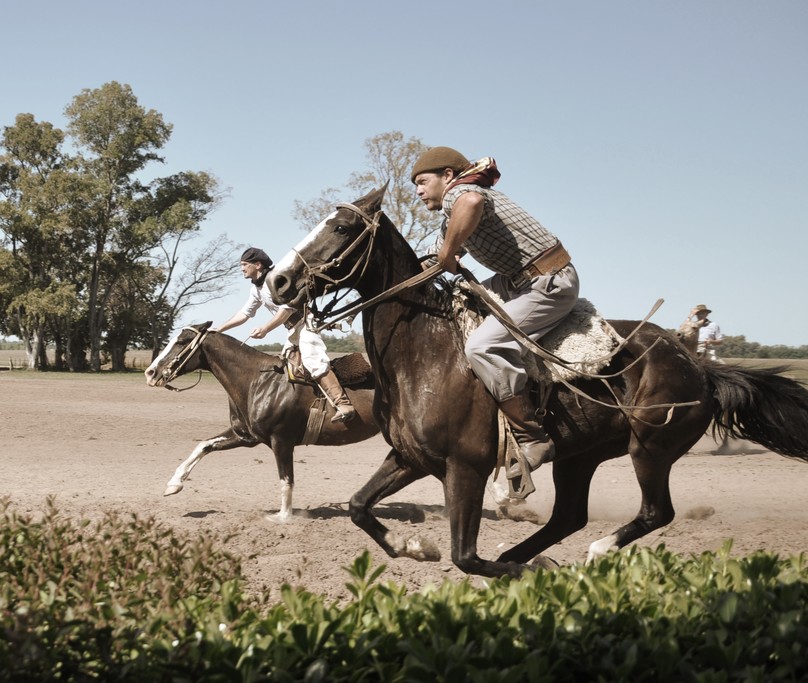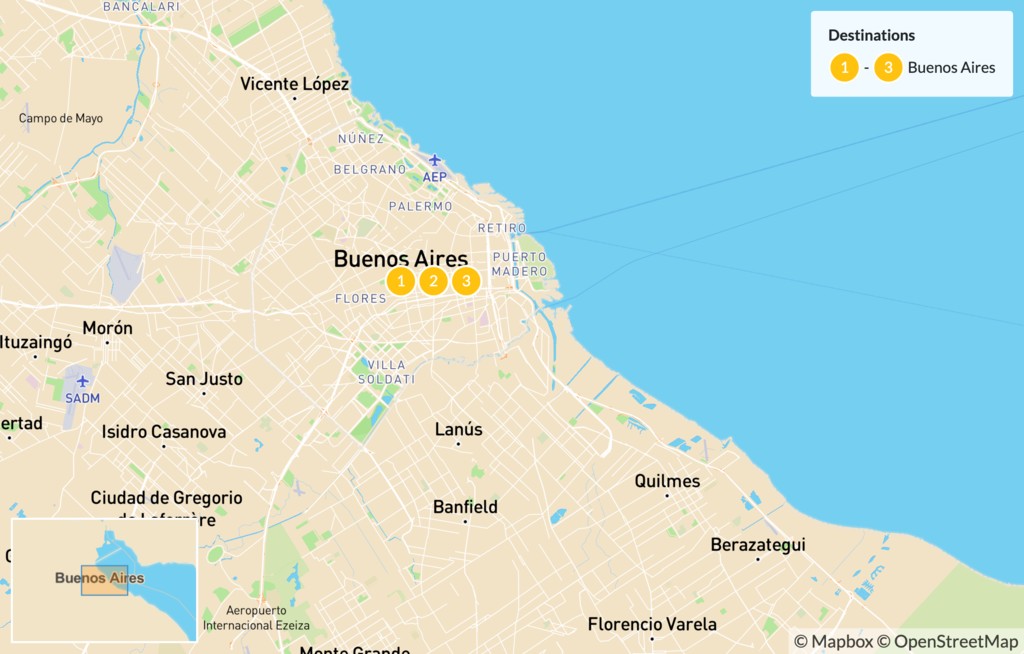
Experience Buenos Aires - 4 Days

Highlights
- Explore the vibrant streets of Buenos Aires on a walking tour
- Take a tango lesson and get in touch with the rhythm of Buenos Aires
- Experience the gaucho lifestyle in rural Argentina
Brief Itinerary
| Day | Highlights | Overnight |
|---|---|---|
| Day 1 | Arrival in Buenos Aires - Explore the City | Buenos Aires |
| Day 2 | Buenos Aires Walking Tour & Tango Lesson | Buenos Aires |
| Day 3 | Gaucho Experience at Estancia Santa Susana | Buenos Aires |
| Day 4 | Goodbye Buenos Aires! |
Detailed Itinerary
Day 1: Arrival in Buenos Aires - Explore the City

Welcome to Argentina! Renowned as the "Paris of South America," and the "Queen of El Plata," the capital city of Buenos Aires is defined by passion. This is exemplified in the rich tango heritage and its citizens' limitless enthusiasm for fútbol (soccer), which is far and away the country's most popular sport.
When you arrive at the airport, your driver will be waiting to take you in a private car to your hotel where you can relax after a long flight. But make no mistake: the city will beckon you. So after a quick recharge, be sure to venture out into the welcoming arms of Buenos Aires and explore. The best starting point would be the city center.
Suggested activities include:
-
Visit the Obelisco, which might be the most famous icon of the city. This obelisk (which even Argentines admit is a little too reminiscent of the Washington Monument) is worth a visit for its location alone. It sits right in the middle of Avenida 9 de Julio, which boasts a whopping 16 lanes, making it the widest city street in the world.
-
Stop by the Teatro Colon, one of South America's premier opera houses. The horseshoe-shaped gallery features 2,487 seats and incredible acoustics. Even if you plan on taking a tour or catching a show here on another day, it's always breathtaking to pass by its exterior. The Colon's neoclassical facade has been the face of one of the most handsome buildings in Buenos Aires since its opening in 1908.
-
Stroll Puerto Madero, an upscale waterfront neighborhood adjacent to downtown. Puerto Madero may be the "new money" finance center of Buenos Aires, but it's also one of the most pleasant walking areas in a city famous for its walking areas. A romantic stroll involves walking over the canal on the Puente de Mujer ("Woman's Bridge") at sunset.
- Dine at an Argentine steakhouse or parilla. When night falls and dinnertime arrives, do like the locals and enjoy a thick, juicy steak (Argentina has some of the best beef in the world) drizzled with the nation's famous chimichurri (a garlic, herb, and vinegar sauce). Know that Buenos Aires is a culture that thrives after dark, and it's not uncommon for locals to have dinner well past nine in the evening, especially on weekends.
Day 2: Buenos Aires Walking Tour & Tango Lesson

One great way to experience Buenos Aires is to do so on foot. So after a fortifying breakfast prepare yourself for some walking and sightseeing throughout this European-inspired metropolis with the aid of an English-speaking guide.
Some highlights of a walking tour around Buenos Aires include:
-
Plaza San Martín, located at the end of downtown's commercial pedestrian thruway, Florida Street. This leafy plaza, anchored by a majestic ombú tree, is named after one of the heroes of Argentina's independence movement, General José de San Martín.
-
The Obelisco, an icon that sits at the nexus of the city where the 16 lanes of Ave. 9 de Julio cross bustling Corrientes Ave. Here you'll find Buenos Aires' theater and music district. It's a hub of activity any day of the week but it's particularly alive on weekend evenings.
-
Colón Theatre, a nearly 2,500-seat teatro that is perpetually vying with Rio de Janeiro's Theatro Municipal for the title of the most opulent opera house in South America. The building's elegant neoclassical exterior and pitch-perfect interior acoustics make this building a must-visit.
-
Plaza de Mayo, which is Buenos Aires' main square and home to the Casa Rosada, Argentina's presidential palace. The plaza is the site of some famous events, including the May Revolution of 1810 that kicked off this former Spanish colony's quest for independence. The famous "pink house" (as the presidential palace is colloquially known), is also rife with history. It's on the front balcony that dictator Juan Perón made some of his most famous speeches with his glamorous wife, Evita, at his side. Ultimately it was she who won the hearts and minds of the Argentine people.
-
Metropolitan Cathedral, is the principal Catholic church in the city and another historic building that also faces the Plaza de Mayo. It was consecrated in 1791 but its earliest origins date back to the late 16th century when a humble chapel first sat on the current site.
-
Puerto Madero, whose shimmering office towers and central canal make this one of the most elegant neighborhoods in the city. Some upscale restaurants can be found here, as can Puente de la Mujer, a bridge whose sleek and sensual lines define its title of "Woman's Bridge."
-
Barrio San Telmo, which is BA’s oldest neighborhood and boasts a vibrant tango and arts scene. Its antique markets, cobbled streets dotted with faroles (French streetlamps), and old brick buildings with wooden balconies all add to the uniquely bohemian atmosphere. Sundays are especially abuzz with activity as the main street market comes alive around Plaza Dorrego.
- Barrio La Boca is a well-preserved historic neighborhood that's nearly as old as San Telmo. The area is known for La Bombonera the stadium of one of two principal soccer teams in the city: Boca Juniors. It's also home to colorful Caminito Street, a pedestrian zone teeming with old restaurants and tanguerías.
In the evening you'll experience an unforgettable night of dinner and tango performances in one of the best tanguerias of Buenos Aires. It's venues such as these that preserve the musical heritage of the city. You'll feel it in the ambiance, you'll hear it in the melancholy rhythms of the guitar and bandoneon, and you'll see it in the dances of fish-netted and besuited bailanderos. It's a dance that tells the story of loss and heartbreak, passion and love.
And if that isn't enough, you'll even have the opportunity to get up on the dancefloor and partake in a tango class.
Walking tour duration: Half day (4 hours)
Chat with a local specialist who can help organize your trip.
Day 3: Gaucho Experience at Estancia Santa Susana

Just as North Americans have their cowboys, Argentines have their gauchos. This frontier culture is strongest in the Pampas (prairies) immediately surrounding the capital, as this is where the country was first settled. Gauchos are national symbols in Argentina, whether it's the real-life horsemen who still exist today, or the folk heroes of epic Argentine poems, like Martín Fierro, whose stories are passed down over the generations.
Today you'll get a real gaucho experience. You'll be picked up in the morning and whisked off to a Santa Susana, a working Argentine estancia (ranch). Here you'll enjoy a welcome reception that includes wine, soft drinks, and empanadas. After a guided tour of the property, you'll do some horseback riding (or perhaps a carriage ride) before settling in for a traditional folkloric music performance—and everyone's invited to get up and dance.
Lunch will be an Argentine asado (mixed grill) paired with even more of the country's fantastic wine. Real gauchos will then showcase their prowess with the bolas—traditional throwing weapons comprised of round weights connected by cords. Their displays will demonstrate how these deceptively simple weapons, when used in the right hands, can be effective at bringing down horses, cows, and even people.
After lunch, you'll be treated to even more entertainment. The gauchos will continue to showcase their abilities, this time as they perform a series feats known as carreras de sortijas ("ring races"). These are typical in gaucho equine competition and showcase these cowboys' great skills on horseback. You will end the day at the estancia with a late-afternoon serving of mate, the popular tea-like infusion that is an indispensable part of Argentine culture.
By the time you transfer back to your hotel in the evening, you can be happy in the knowledge that you've enjoyed a traditional Argentine frontier experience.
Day 4: Goodbye Buenos Aires!

Enjoy your last hours in the cosmopolitan capital of Buenos Aires. At the scheduled time, your driver will pick you up and transfer you by private car to Ezeiza International Airport, where you'll catch your return flight home.
